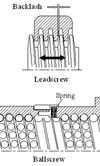A Material World
 If you were to compare an engine of today with one built, say for instance 50 years ago, no doubt much will have changed. Cylinder head layout, block construction, pistons, rods and cranks have all changed in their various ways. But the one component that is outwardly very similar, having changed very little in that time, is the camshaft. That is not to say there has been little development over the years. Hollow cams, smaller cams, bigger cams, even multiple cams per valve have all been tried and adopted to some extent but when it comes down to it, how many variations of getting a series of valve moving profiles onto a stick can you envisage?
If you were to compare an engine of today with one built, say for instance 50 years ago, no doubt much will have changed. Cylinder head layout, block construction, pistons, rods and cranks have all changed in their various ways. But the one component that is outwardly very similar, having changed very little in that time, is the camshaft. That is not to say there has been little development over the years. Hollow cams, smaller cams, bigger cams, even multiple cams per valve have all been tried and adopted to some extent but when it comes down to it, how many variations of getting a series of valve moving profiles onto a stick can you envisage?
But the one area that has changed over the years, however subtle to the layman, is the material. Although predominantly ferrous based, even in Formula One (as required by the current regulations), slight changes to the material specifications have been deemed necessary depending on things like the aggressiveness of the profile, the location of the part and in many cases, the cost economics at the time. Throughout time, camshafts have been made out of various types of iron. Early mass production, pre-WW2 examples were made from hardenable iron. A Grade 17 (now referred to in BS 1452 :1990 as a flake iron Grade 250 - 250 N/mm2 being it’s tensile strength ) cast iron, this 1% chrome iron had a much finer grain structure and graphite distribution than most cast irons of the day. Designed primarily for block-mounted camshafts where an abundance of splash lubrication from the sump was available, these were flame or induction hardened prior to final profile grinding. Not suitable for overhead cam applications because of the lack of adequate lubrication, this material attracted a poor reputation in early OHC designs. Replaced by a similar grade 250 cast iron but this time poured into steel moulds in the shape of the cam lobe, the chilling effect on the molten iron produces a very hard and difficult to machine ‘white’ iron surface. This ‘chilled’ cast iron is still very popular in production engines of all types today but can only be used when production volumes can justify the extra costs of making them.
When the additional costs of these chilled castings cannot be easily amortised, or where a more specialist application is envisaged, steel remains the only other realistic alternative. Plain medium carbon steels like EN8 and 9 when flame or induction hardened were entirely acceptable and certain types of alloy steel (EN351, EN34 and AISI 8620) have been frequently used when used against a chilled cast iron follower. However the most popular material of all and still used widely today in the UK is that of EN40B. Now referred to as BS 970 722M24 and a slightly tighter specification, this chrome-molybdenum steel when supplied in a fully hardened and tempered condition is highly wear resistant with excellent toughness. A nitriding steel (a process by which the surface layers of the material are enriched with nitrogen) using 3% molybdenum, its tensile strength is around 920 N/mm2.
When a slightly higher spec can be afforded the almost identical aircraft quality spec BS S106 is available with tensile strengths quoted from 930 to 1080 N/mm2. Although very similar to 722M24 if not quite identical, this material is claimed to have fewer inclusions and therefore is ultimately stronger. For higher performance still, S132 can be used. Referred to as a chrome-moly-vanadium steel, this offers a tensile strength of between 1320 – 1470 N/mm2 representing high core strength and excellent surface hardenability. And if for some reason you are not totally happy with that, then a specialist steel manufacturer will no doubt will be happy to supply you with some of their deep nitrided GKH steels for use when even higher fatigue loads are expected.
Cast, steel billet or gundrilled, outwardly the camshaft doesn’t appear to have changed very much at all. Inwardly however, very careful and subtle changes have taken place.
Written by John Coxon.